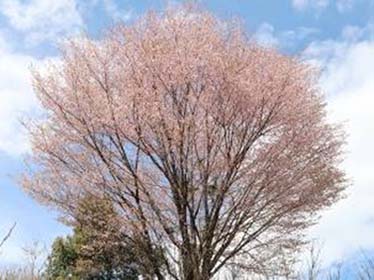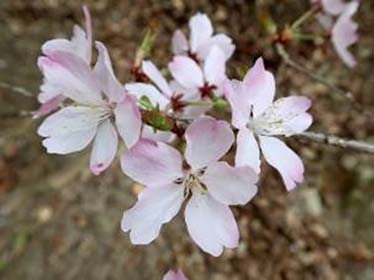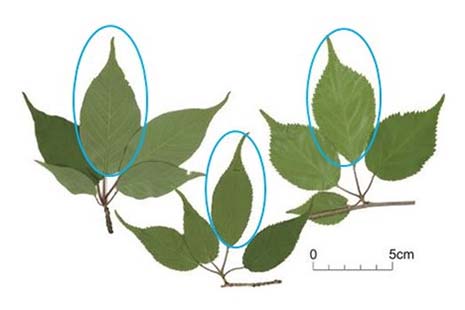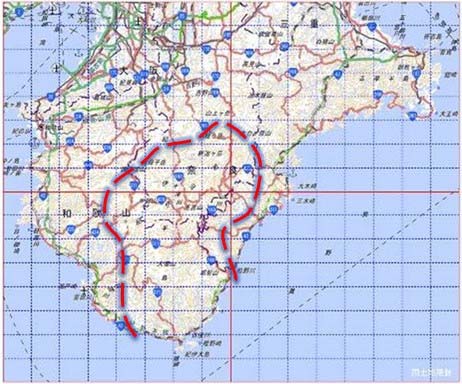Home > Research > Research Results > Research Results 2018 > A new species Cerasus kumanoensis discovered from the Kii Peninsula: promising as an ornamental cherry tree
Update:September 18, 2018
Main content starts here.
A new species Cerasus kumanoensis discovered from the Kii Peninsula: promising as an ornamental cherry tree
| Article title |
A new species Cerasus kumanoensis from the southern Kii Peninsula, Japan |
|---|---|
| Author (affiliation) |
Toshio Katsuki Tama Forest Science Garden, FFPRI, Hachioji, Tokyo, Japan. |
| Publication Journal |
Acta Phytotaxonomica et Geobotanica, 69(2):119-126, June 2018, DOI:10.18942/apg.201801( External link ) |
| Content introduction |
Nine species of Cerasus are native to Japan; in addition, there are many cultivars, including C. ×yedoensis 'Somei-yoshino' (* 1). We, at the Forestry and Forest Products Research Institute (FFPRI), are pursuing research to reveal the mutations in wildtype species with the goal of reconstructing the Cerasus taxonomic system. However, during an investigation of gene mutations in C. jamasakura, which was conducted by the FFPRI and other entities and published in 2014, some samples from the Kii Peninsula appeared to be different from the existing species. C. jamasakura plants in western Japan have more mutations, and local variants may have emerged in the Kii Peninsula. In addition, Cerasus with a high ornamental value is promising as a new resource. Therefore, we conducted a field survey in the Kii Peninsula and characterized an unknown Cerasus species in detail. The FFPRI and Wakayama Prefecture Forestry Experiment Station jointly conducted a field survey from 2016 to 2017 and characterized cherry trees distributed in the Kii Peninsula. We found a Cerasus species that was distinct from the native C. jamasakura or C. leveilleana (Fig. 1, 2). It was characterized by short, hairless peduncles (Fig. 3) and narrowly ovate leaves, which were smaller than those of C. jamasakura or C. leveilleana (Fig. 4). In addition, its flowering period was earlier than that of the two native species, with no overlap (Fig. 5). Many wild trees of this unpublished species were found distributed across an area of 90 km from north to south and 60 km from east to west around the Kumano river basin (Fig. 6). Based on these characteristics, we concluded that this is a new species (* 2) and named it Kumano cherry (C. kumanoensis). The scientific name of this species was published in Acta Phytotaxonomica et Geobotanica, a journal of the Japanese Society for Plant Systematics, vol. 69, issue 2, in June 2018. This is the first new Cerasus species discovered in approximately 100 years after C. speciosa, which was published in 1915.
* 1 Species and Cultivars The basic taxon for wild plants is a species, and scientific names of species are determined by the International Code of Nomenclature for algae, fungi, and plants (ICN). In case of cultivated plants, the taxon is a cultivar, and scientific names of cultivars are determined by the International Code of Nomenclature for Cultivated Plants (ICNCP). * 2 New species
Figure 3. Inflorescences of C. jamasakura (left), C. kumanoensis (center), and C. leveilleana (right; peduncles are indicated with red circles)
Figure 4. Mature leaves of C. jamasakura (left), C. kumanoensis (center), and C. leveilleana (right; leaf blades are indicated with blue circles)
Figure 5. Flowering periods in 2017 for C. kumanoensis and C. jamasakura (native), C. ×yedoensis 'Somei-yoshino', and C. leveilleana (planted) in Kozagawa-cho, Wakayama prefecture
Figure 6. Estimated distribution area of C. kumanoensis |
Copyright © Forest Research and Management Organization. All rights reserved.






